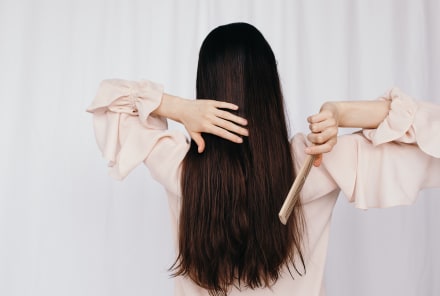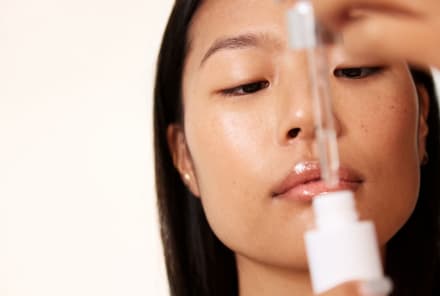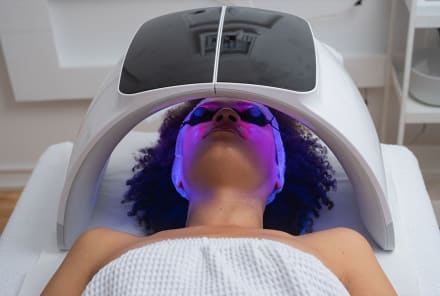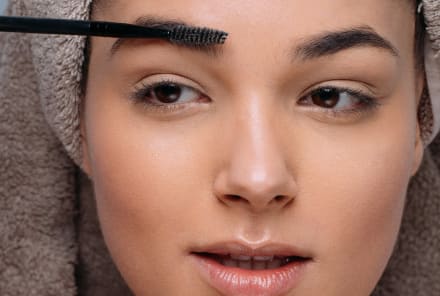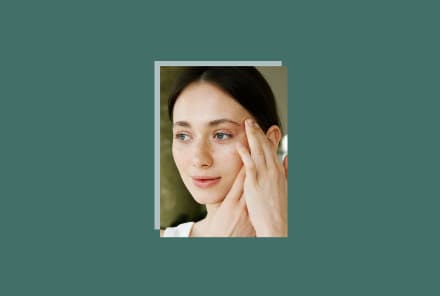Advertisement
How To Get Rid Of Hangnails + Causes & Prevention, From Experts


If you haven't gone to the doctor for a hangnail before, knock on wood. Even if you haven't seen the worst of it, it's safe to say most people have had—and likely despised—at least one or two hangnails in their lifetime.
Hangnails are so common it might seem like there's nothing you can do to prevent them, even if you regularly tend to your nails at home. PSA—that's not exactly the case.
Here's the 101 on hangnails, from causes to treatment and prevention, so you can be prepped and ready next time one pops up—plus, why you might be extra prone to getting them in the first place.
What are hangnails?
Major first note—hangnails aren't even made up of the nail at all. "Hangnail is actually a misnomer because a hangnail is not composed of 'nail' but actually a small segment of cuticle that detaches and 'hangs,'" board-certified dermatologist and nail expert Dana Stern, M.D., tells mbg.
So hangnails actually have more to do with your cuticles than the nail itself. That being said, certain nail habits, practices, and products can make the cuticle become dry—which in turn creates a hot spot for hangnails.
How to safely get rid of hangnails.
Once you have a hangnail, there are at-home measures you can take to get rid of it. This protocol should happen early on—read: before your finger is swollen and filled with pus.
Step 1: Wash your hands + tools.
"Wash hands with an antibacterial soap to ensure that the area that you will be treating is clean," Stern says. You'll want to minimize the chance of bacteria carrying over from anything you've touched. Typically we advise using more gentle hand wash formulas with less stripping surfactants, but this is an instance in which you should be as hygienic as possible. There's higher risk of infection here, and that's not to be messed with.
In the next step, you'll want to use a cuticle trimmer, so be sure to clean it beforehand. Swipe an alcohol tab over your tool before using it, or soak it in alcohol and dry off with a clean towel.
Step 2: Take a cuticle trimmer and gently trim.
"Use a clean cuticle nipper to carefully remove at the base," Stern says. When you go in to trim the skin, don't go so far down that you poke into the skin, but be sure to get to the base of the hanging skin.
This is much safer than pulling or biting, Stern says, "Both of which can lead to irritation."
Step 3: Moisturize the affected area.
Moisturize the affected area with a fragrance-free ointment or oil. Here's a list of our go-to clean formulas to get you started. Keep up with the topical hydration for a week after your hangnail is trimmed to prevent the hangnail from coming back and future hangs from popping up.
Why do people get hangnails? 8 common causes.
If you regularly get hangnails, there are a few different parts of your routines and habits to take a closer look at. The most common include:
Picking or biting the nails or cuticles.
"Picking (onychotillomania) or biting (onychophagia) can physically separate or lift the cuticle away," Stern explains.
If you pick or bite your nails—don't be too hard on yourself. Oftentimes this can be a nervous tick or a coping mechanism for chronic or situational anxiety. We'll dive deeper into a few ways to ease this habit to follow.
Dry hands.
"A dry, dehydrated cuticle is more prone to lifting and separating and thus becoming a hangnail," Stern says. Simply having dry hands to the touch is often caused by an external factor (a few popular ones to follow). However, hand eczema is also a possibility, but it's generally more severe than just dryness alone.
"Hand eczema, or hand dermatitis, is characterized by redness, blistering, cracking, flaking, and itching of the palms and fingers," board-certified dermatologist Hadley King, M.D., once told mbg. Of course starting with preventing dry skin is a great first step, but hand eczema will likely require more intervention than just a great hand lotion—so it's best to see your dermatologist if you suspect you have eczema on the hands, or anywhere else on the body for that matter.
Damaged nails.
If your nail is broken, the sharp clipping could potentially poke into your cuticle and cause it to become irritated and lift from the nail as well. So if you break a nail, be sure to file it down smoothly to prevent any loose or sharp edges.
Frequent hand washes & sanitizer.
If you constantly wash your hands or use hand sanitizer, the skin around your nails will become dry. If you don't replenish the moisture, you're more susceptible to peeling cuticles and hangnails.
Working with your hands.
"Any activity that predisposes the nail area to trauma or where the hands are immersed in chemicals or water will serve as a risk for the development of hangnails," Stern notes.
Certain occupations that call for frequent hand-washing are particularly prone to dry cuticles, including anyone working in the food industry, health care, hairdressers, etc.
Using drying formulas.
"Choice of products will impact your risk for the development of hangnails," Stern says. Nail polish removers and alcohol-based products can be particularly drying. If you're using an astringent product, be sure to rinse it off ASAP.
Using damaging nail products.
Acrylic and dip powder formulas contain harmful ingredients like resin and formaldehyde, which can contribute to thinner nails and breakage. Plus, if you get any glue or hard dip on the side of your cuticles, there's a high chance you'll have to clip it off, tearing the skin.
Of course, not everyone can—nor wants to—avoid acrylic tips or gel polishes and that's perfectly fine. However, you should be extra mindful of tending to your cuticles, so take note of the preventive measures below.
Swimming.
Board-certified dermatologist Hadley King, M.D., notes swimming in a chlorinated pool as one often overlooked cause of frequent hangnails. Chlorine can dry out the skin on your nails (and your body skin, facial skin, and hair too).
If you swim frequently, whether it be in saltwater or chlorinated pools, be sure to pay special attention to moisturizing after you hop out. If you can, rinse off right as you exit the pool to ensure the chlorine doesn't sit on the skin for too long.
How to prevent hangnails.
Treating a hangnail is immensely more difficult, risky, and possibly painful than prevention. Whether you're prone to a hangnail or two every once in a while or you get them all of the time, proper nail and cuticle care will save you from some discomfort.
Address picking & manage stress.
As mentioned earlier, picking or biting your skin and nails is often a nervous tick or a product of stress. If you know this is a habit you want to kick, check out this story for more info. Here are a few quick tips to get you started:
- Identify your triggers.
- Keep your hands busy.
- Keep your nails short.
- Apply a foul-tasting polish so you won't be tempted to bite.
- Chew gum or eat mints instead.
- Contact a mental health expert if you feel your nervous ticks are impacting your day-to-day life. Here's our guide to finding a therapist for your needs.
Use cuticle oils.
The cuticle area is extremely prone to dryness, so keep it moisturized at all times. Pack a cuticle oil in your bag, keep one by your vanity, on your desk, etc. If absolutely nothing else, be sure to slather on some oil before bed every evening—here's a list of top picks to make it easy.
Use hand cream daily.
If you struggle with dry hands and cuticles, then keep a hand cream on deck too. "Use hand cream or cuticle oils on a daily basis, especially during the cold season," Ling says.
If you want to go all out, apply hand lotion, followed by a cuticle oil to seal in the moisture—think of it like slugging but for your nails.
Wear gloves when handling chemicals.
"Always wear gloves when doing a lot of wet work or if you have a lot of exposure to chemicals," Stern says. This means cleaning, washing dishes, etc.
Re-evaluate your nail care formulas.
If your nails are becoming thin and brittle, you get hangnails often, or you find the skin around your nails to be red and itchy, you might want to reevaluate what kind of nail care you're using.
Especially for those with sensitive skin, ingredients like formaldehyde can wreak havoc on more than just the nail itself. Instead, opt for nontoxic nail polish—here are 13 A+ brands to shop.
Get regular manicures.
If your hangnails come from picking at your skin, then investing in regular manicures isn't a bad idea. This way, a professional nail technician can help keep the skin around your nails clean and healthy, leaving less broken-off skin to tug on.
Plus, manicures serve as a moment of self-care, where you have no choice but to be mindful while your nails are being tended to. Nail and skin care are part of full-body health care and shouldn't be viewed as just an appearance-based or frivolous investment.
Should you see a doctor?
Here's the thing—a minor hangnail can certainly be treated at home with the protocol listed above. In fact, "Most hangnails do not require medical intervention," Stern says. But once it begins turning into an infection, that's when you'll want to visit a doctor.
Not sure if it's time to schedule a visit? Here are a few signs you might not be able to DIY your hangnail, according to Stern and King:
- The affected area is warm.
- There's pain around the area.
- Intense redness.
- Swelling.
- You see pus or blood.
- If it persists beyond a week.
Trust, you should definitely see a medical professional if any of those signs ring true for your hangnails. If you don't, you'll run the risk of the infection getting worse, causing more pain, and possibly even spreading. It's always better safe than sorry, after all.
FAQ
How do I stop getting hangnails?
There are many skin care and lifestyle habits to adopt that can help prevent hangnails from forming. First, it’s very important that you try and stop picking or biting. It’s also very important to keep your hands and cuticles hydrated with a cream or oil. For those who regularly work with your hands, try and wear gloves when possible. And to help keep the nails clean and trimmed you can also opt for regular manicures.
Will hangnails go away on their own?
When left alone, yes, hangnails will go away on their own in a few days or week. However, if a hangnail becomes infected, it should be treated with an antibiotic ointment.
What deficiency causes hangnails?
While hangnails are usually caused by other factors (dry skin, physical damage, and picking), they can be a sign of a protein deficiency, as well as vitamin C, B, or folic acid.
The takeaway.
Hangnails are certainly annoying to deal with, but if you're not careful, they can actually turn into a much larger problem. If you're prone to hangnails, focus on avoiding drying products and picking at your nails and prioritize moisturizing every chance you get. And when pain, redness, or swelling starts to creep up on you, seek professional help ASAP. If you want to dive deeper into cuticle care 101, start here.
-v1646695196476.jpg?1148x800)
